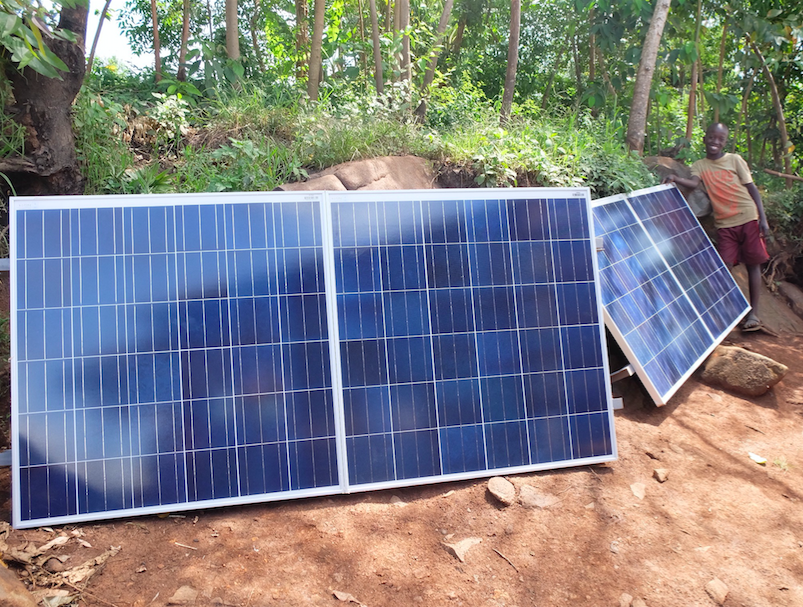"Into The Light" Short Video - https://youtu.be/9u4dVvpHpbA
Arrive is thrilled to introduce our new solar solutions at the Light Home of Hope and Light School in Uriri, Kenya! This $4,992.88 project was no easy task, and thanks to the hard work of fundraising Julia - pictured in Uriri on the right, current student at Boston College and currently volunteering in Kenya with Arrive - we have been taken out of the dark. The outcome of a successful solar power project in rural Kenya is provides exponentially more tangible impact than a solar power project in a first world country.
The solar panels and batteries, which have been integrated with our electrical grid of Light Home of Hope, power both our childrens home (both dormitories, study room, volunteer headquarters, main house, and more) and the entire Light School and its 423 students! The solar project adds 45 days to each year per person; read below to find out how!
As part of constructing a happy and holistic environment for the Arrive children, environmental sustainability is a central goal and must be incorporated into the home. In rural Kenya, although receiving 12 hours of sunlight daily, costly and unreliable power make studying hard with no proper lighting at night. By taking advantage of our position on the equator and adding a solar power system consisting of panels and batteries, we've increased our environmental sustainability, financial sustainability, and quality of life of the children we serve.
To understand the potential of a reliable, renewable, and efficient source of energy, the typical day for a student in rural, sub-Saharan Africa must be examined. The suns rises at 7:00am sets at 7:00pm every day of the year in rural Kenya, an area in which electricity is rare and when connected is unreliable. Kenya’s location on the equator provides the country with much sun, a steadfast 7:00pm sunset, and opportunities to utilize solar power. The “active” hours of the day, meaning the hours during which the sun is up and work can be done without the need of artificial light, are 6:00am – 8:00pm. This includes one hour of dawn before sunrise and one of hour of dusk after sunset. During these 14 hours, nearly every job of the day must be completed: teachers teach with no light bulbs in the room; students are able to study without using any electricity; farmers tend their crops; construction workers build. In rural Kenya, day jobs are followed by chores: washing clothes; fetching clean water; collecting firewood; tending to livestock; building then cooking over a fire. In most households, the responsibility is left to the kid(s) to carry out a majority, if not all, of these chores before s/he leaves for school in the morning and after s/he returns home from school in the evening. It is common practice for children to start chores at a very young age. If parents fall ill with HIV/AIDS, or if a large family lacks resources, students often times are taken out school to instead complete these chores for the family. For students who remain in school and return to their homes by 5:00pm, there are only 3 hours before 8:00pm. Unable to see, focusing on homework and school assignments is near impossible until the following morning. Without electricity, these “dormant” hours are 8:00pm – 6:00am (10 total hours).
Most rural homes in Kenya do not have electricity. For the lucky families and institutions (like us) who can afford the relative luxury, it is often unreliable with frequent blackouts. The poorest families do not have enough money for candles or matches; for 10 hours everyday, they are literally in the dark. Adding a solar energy system to the Light Home of Hope has, based on a conservative estimate, increase each student’s “active” hours by 1 hour in the morning (5:00am – 6:00am) and 2 hours at night (8:00pm – 10:00pm). The 3-hour (21.4%) increase provides our dedicated students an extra 21 hours every week to read, write, study, learn, and be engaged. Solar panels securely mounted on the home’s roof will collect sunlight all day. Batteries inside the home store the energy and are connected to the main power system on the Light Uriri campus. From 6:00am – 8:00pm, no solar power is needed as natural sunlight is sufficient. From 5:00am – 6:00am and 8:00pm – 10:00pm daily, the stored energy can be used to light rooms and outdoor areas. Solar energy will provide the children with 21 extra hours of light per week – the equivalent of nearly one full extra day, every single week. Each child who lives at Light Home of Hope may receive up to 1,095 hours (equivalent to over 45 days) of light every year, unless s/he sleeps late on the weekends!
The solar energy system also connects to the Light School to provide the 423 students with better-lit classrooms before school. For students who use the time after school but before sunset to complete chores, 5:00am – 6:00am before school is their hour of opportunity to accomplish schoolwork from the previous day or receive much-needed tutoring. This opportunity comes by way of a well-lit classroom available to students and teachers before school. With a reliable source of power, the students won’t have to worry about having enough hours of sunlight to finish on their homework – light will be guaranteed everyday.
Solar power fights against global warming by reducing greenhouse gas emissions from traditional fossil fuels like coal. On top of solar energy’s environmental benefits, Arrive would no longer need to pay for an unreliable, expensive source of electricity to light the home at night. The solar energy will decrease our carbon footprint and our electricity bill.
Our solar solutions project includes:
(6) 150 watts solar panels
(4) Solar 200AH 12V CEIL sealed batteries (143 lbs EACH battery!)
(1) TriStar 45A charge controller
(1) Mult+1212W INV.CH-Victron
(1) Solar AVS switch 30 AMPS
(1) Solar 40 AMPS change over switch
All the materials needing for mounting, wiring, and the labor cost of installation
Our solar energy project at Light Home of Hope will demonstrate the importance, to young boys of girls of rural Africa, of a sustainable, efficient, and renewable source of energy. Encouraged to explore the countless benefits offered by other sustainable projects, those children will grow up to one-day help provide renewable energy to the 634 million people (worldenergyoutlook.org) in sub-Saharan Africa who currently lack electricity – literally taking them out into the light.






